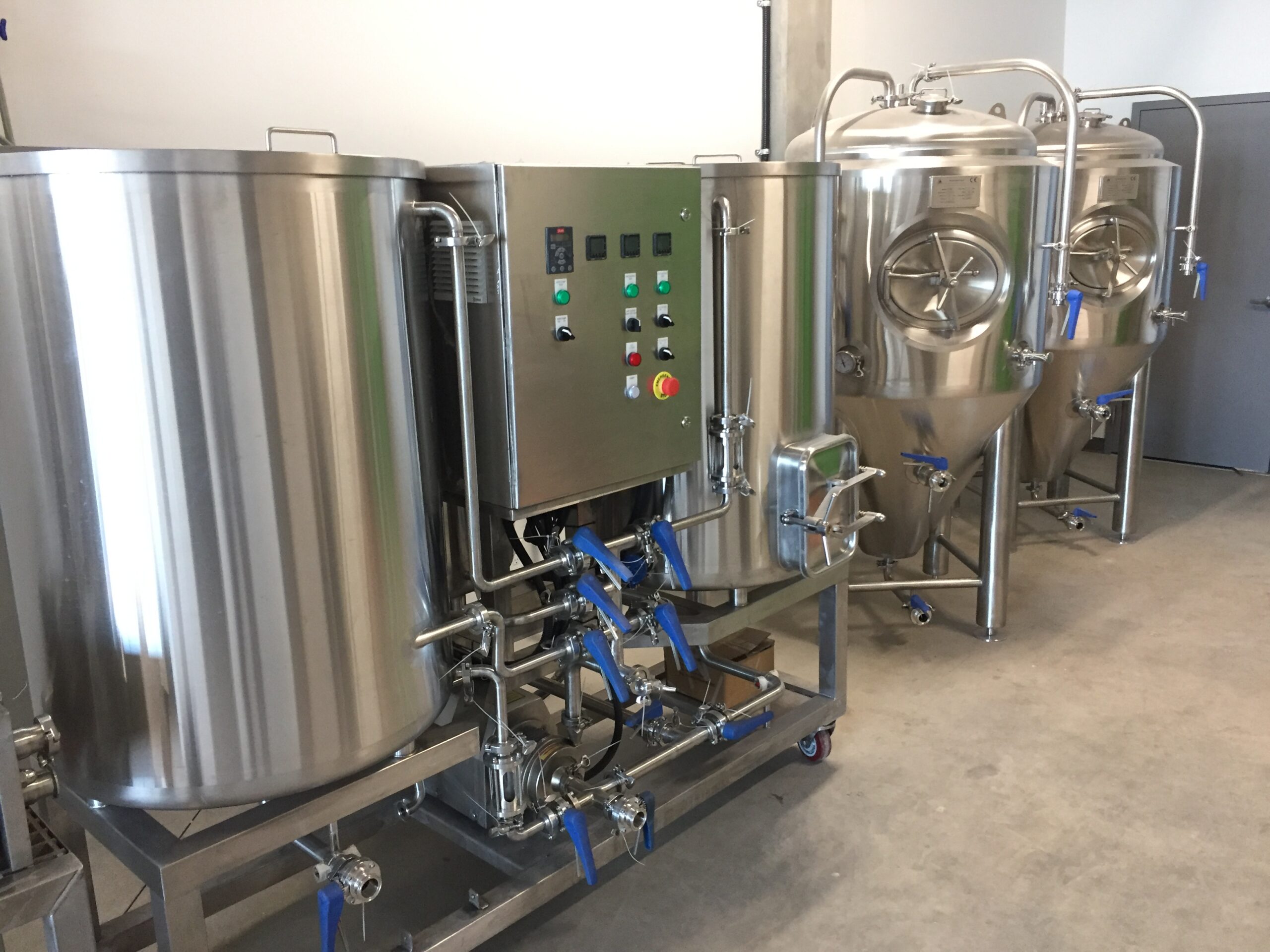The Butterfly Valve:
The butterfly valve has a long history in various industries, including the craft beer industry. While it’s challenging to pinpoint the exact origins of the butterfly valve specifically for craft beer, we can provide a brief overview of the development of butterfly valves and their adoption in the brewing industry.
The butterfly valve concept dates back centuries, with early designs resembling the shape of a butterfly’s wings, hence the name. However, these early versions were relatively basic and lacked the sophisticated features found in modern butterfly valves.
In the context of the craft beer industry, the adoption of butterfly valves can be attributed to the broader advancements in valve technology and the increasing demand for efficient and sanitary solutions. As craft breweries began to emerge and grow in popularity during the late 20th century and early 21st century, there was a need for valves that could meet the specific requirements of these smaller-scale brewing operations.
Butterfly valves gained traction due to their advantageous characteristics, such as ease of operation, cost-effectiveness, and sanitary design. These valves offered craft brewers a reliable and efficient way to control the flow of liquids throughout the brewing process while maintaining the desired levels of hygiene.
Furthermore, the growing availability and affordability of stainless steel, a common material used in butterfly valve construction, also contributed to their adoption in the craft beer industry. Stainless steel provides excellent durability and corrosion resistance, making it suitable for the demanding and often corrosive environments of breweries.
Over time, butterfly valves have become a popular choice among craft brewers for various applications, including controlling the flow of wort during mashing, transferring liquids between vessels, regulating the flow of fluids during fermentation, and managing the movement of finished beer during packaging.
The Pneumatic Valve
Pneumatic valves have played a significant role in the craft beer industry, providing efficient and automated control over various processes. Let’s explore a brief history of pneumatic valves and their adoption in craft beer production.
Pneumatic valves, which are valves operated by compressed air or gas, have a history that predates their specific application in the craft beer industry. The development of pneumatic systems and valves can be traced back to the Industrial Revolution in the 18th and 19th centuries. During this period, advancements in steam power and compressed air technology led to the emergence of pneumatic control systems.
In the context of craft beer, the adoption of pneumatic valves grew alongside the overall automation and modernization of breweries. As craft brewing expanded and became more sophisticated, brewers sought ways to streamline their processes and improve efficiency.
Pneumatic valves offered several advantages that made them well-suited for the craft beer industry:
Automation: Pneumatic valves could be integrated into automated systems, allowing for precise control and reliable operation of various brewing processes. This automation reduced the need for manual intervention, improved consistency, and freed up brewers to focus on other critical tasks.
Quick And Precise Control: Pneumatic valves could rapidly open, close, or modulate the flow of liquids or gases. This responsiveness allowed brewers to achieve precise control over the flow rates, pressures, and timing of different fluids during mashing, fermentation, filtration, and other stages of the brewing process.
Sanitary Design: Pneumatic valves could be designed to meet the sanitary requirements of the brewing industry. They could be made from materials such as stainless steel, which is resistant to corrosion and can withstand the harsh cleaning and sterilization procedures necessary in breweries.
Versatility: Pneumatic valves could be used for various applications within a craft brewery, including controlling the flow of ingredients, transferring liquids between vessels, regulating temperature, and managing the movement of beer during packaging.
As craft breweries continued to grow and invest in automation and process optimization, pneumatic valves became an integral part of their operations. These valves facilitated greater efficiency, consistency, and quality control, allowing brewers to scale their production while maintaining the craftsmanship and attention to detail that defines the craft beer industry.
Today, pneumatic valves remain a crucial component in many craft breweries, working in conjunction with advanced control systems to ensure precise and reliable control over the brewing process. They contribute to increased productivity, reduced manual labor, and improved product consistency, helping craft brewers meet the growing demand for their unique and flavorful beers.
The Benefits of Butterfly Valves
Butterfly valves are commonly used in craft beer making for various reasons and offer several benefits. Here are some of the advantages of using butterfly valves in the craft beer industry:
- Cost-effective: Butterfly valves are generally more affordable than other types of valves, such as ball valves or diaphragm valves. This cost-effectiveness is particularly beneficial for small-scale craft breweries or those on a limited budget.
- Easy operation: Butterfly valves are designed for easy operation, allowing brewers to quickly control the flow of liquid or gases in their brewing process. The quarter-turn operation of the valve lever or actuator makes it convenient to open or close the valve, saving time and effort during brewing operations.
- Efficient flow control: Butterfly valves offer excellent flow control capabilities. When fully open, butterfly valves have a minimal pressure drop, allowing beer to flow smoothly through the system without excessive turbulence or restrictions. This is crucial for maintaining the desired flow rates during various stages of the brewing process.
- Sanitary design: In craft beer production, maintaining sanitary conditions is essential to prevent contamination and ensure product quality. Butterfly valves are available in sanitary designs that meet industry standards, such as those with sanitary clamps or tri-clamp connections. These valves are easy to clean and sterilize, minimizing the risk of bacterial growth and ensuring hygienic brewing operations.
- Compact and space-saving: Craft breweries often have limited space available for equipment. Butterfly valves are compact in design and require less space compared to other valve types. This compactness allows brewers to optimize their floor space and arrange their brewing equipment more efficiently.
- Versatility: Butterfly valves are suitable for a wide range of applications within the brewing process. They can handle both liquid and gas flow, making them ideal for controlling the movement of beer, wort, water, and other fluids throughout the brewing system.
- Durability: Craft breweries typically require valves that can withstand frequent use and the demands of a production environment. Butterfly valves are known for their durability and long service life. They are often made from stainless steel or other corrosion-resistant materials, ensuring they can withstand the harsh conditions encountered in a brewing environment.
The Benefits of Pneumatic Valves
Pneumatic valves are widely used in craft beer making due to their numerous benefits. Here are some advantages of utilizing pneumatic valves in the craft beer industry:
- Precise control: Pneumatic valves offer excellent control over the flow of liquids and gases. They can be easily automated and integrated into a control system, allowing brewers to precisely regulate the flow rates and pressures during various stages of the brewing process. This level of control helps maintain consistency and quality in the final beer product.
- Quick response and high-speed operation: Pneumatic valves operate quickly, responding rapidly to control signals. This attribute is particularly beneficial in processes that require rapid changes in flow rates or immediate shut-off. The fast response time of pneumatic valves ensures efficient and accurate adjustments during brewing operations.
- Easy integration with automation: Craft breweries often utilize automation to streamline their operations and improve efficiency. Pneumatic valves are well-suited for automation systems, as they can be easily controlled by pneumatic actuators and integrated with programmable logic controllers (PLCs) or other control devices. This enables the automation of valve operations, reducing manual labor and enhancing overall process control.
- Sanitary design: Maintaining sanitary conditions is crucial in the brewing industry to prevent contamination and ensure product quality. Pneumatic valves can be found in sanitary designs, featuring smooth surfaces and easy-to-clean materials. This makes them suitable for use in hygienic brewing environments, where regular cleaning and sterilization are essential.
- Durability and reliability: Pneumatic valves are known for their durability and reliability. They are designed to withstand frequent operation and harsh brewing conditions without compromising performance. These valves are often made from corrosion-resistant materials, such as stainless steel, ensuring longevity and minimizing the risk of valve failure.
- Flexibility and versatility: Pneumatic valves are available in a wide range of sizes, types, and configurations, making them versatile for various applications in the craft beer industry. Whether it’s controlling the flow of liquids, gases, or steam, pneumatic valves can accommodate diverse requirements and fit into different parts of the brewing process.
- Safety features: Pneumatic valves often come with built-in safety features, such as fail-safe mechanisms or position indicators. These features help ensure safe operations and provide visual or audible signals to indicate the valve’s position or status. Safety is crucial in the brewing industry, and pneumatic valves can contribute to maintaining a secure brewing environment.
Brewers Often Prefer Butterfly Valves For Several Reasons:
Sanitary Design: Butterfly valves are known for their sanitary design, which is crucial in the brewing industry to maintain the quality and integrity of the product. They are designed to be easy to clean and prevent contamination, as they have a smooth interior surface with minimal crevices where bacteria or residue can accumulate.
Flow Control: Butterfly valves offer excellent flow control capabilities. They have a disc or plate that rotates inside the valve body, allowing for precise adjustment of the flow rate. Brewers can easily regulate the flow of liquids, gases, or other media through the valve, which is important for maintaining consistency in the brewing process.
Cost-Effective: Butterfly valves are generally more cost-effective compared to other types of valves, such as ball valves or diaphragm valves. They are simpler in design and require fewer components, resulting in lower manufacturing and maintenance costs. This cost advantage is attractive to brewers, especially in larger-scale brewing operations where numerous valves are needed.
Quick Operation: Butterfly valves are known for their quick and easy operation. They can be opened or closed rapidly, which is advantageous in brewing processes that require frequent valve adjustments or shut-offs. This efficiency saves time and improves overall production throughput.
Space-Saving: Butterfly valves have a compact design and take up less space compared to other types of valves. This can be particularly advantageous in breweries where space is limited, as it allows for more efficient layout planning and optimization of the production area.
Durability: Butterfly valves are typically made from robust materials such as stainless steel, making them durable and resistant to corrosion. This durability ensures a longer lifespan and reduces the need for frequent replacements or repairs, ultimately leading to cost savings for brewers.
As the craft beer industry continues to evolve, it’s likely that butterfly valves will remain a preferred choice for many brewers due to their reliability, cost-effectiveness, and ability to meet the sanitary requirements essential for producing high-quality beer. It’s important to note that while butterfly valves have numerous benefits, different breweries may have specific requirements or preferences based on their unique processes and equipment. Therefore, other types of valves, such as pneumatic valves, ball valves, or diaphragm valves, may also be used depending on the specific application within the brewing industry.

